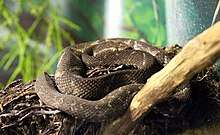Bothrops alcatraz
Bothrops alcatraz is a venomous pitviper species found only on the Alcatrazes Islands off the coast of southeastern Brazil. No subspecies are currently recognized.
| Bothrops alcatraz | |
|---|---|
 | |
| Scientific classification | |
| Kingdom: | Animalia |
| Phylum: | Chordata |
| Class: | Reptilia |
| Order: | Squamata |
| Suborder: | Serpentes |
| Family: | Viperidae |
| Genus: | Bothrops |
| Species: | B. alcatraz |
| Binomial name | |
| Bothrops alcatraz Marques, Martins & Sazima, 2002 | |
| Synonyms | |
| |
- Common names: Alcatrazes lancehead.[1]
Description
Grows to a maximum size of 46.2/50.5 cm for males/females. Its small size and relatively large eyes are considered paedomorphic (juvenile) characteristics.[1] Until 15,000 thousand years ago, only common Bothrops lived by the island, which was at that time still connected to the continent due to the receded sea waters. When the sea rose back again (with the end of the last glacial period) and the mountain returned to its archipelago status, the Bothrops that became isolated there quickly fed on all available rodents, which are its main food. They ended up resorting to cockroaches and scolopendra and, due to their much smaller nutritional value, the snakes slowly shrunk their size until they couldn't grow beyond 50 cm - a process known as allopatric speciation.[2]
Geographic range
Found only on Ilha Alcatrazes, 35 km off the coast of São Paulo, southeastern Brazil. This island, which has a total area of only 1.35 km², is one of four islands than make up the Alcatrazes Archipelago. The type locality given is therefore the same: "Alcatrazes Island, (24°06'S, 45°42'W), São Sebastião, São Paulo, Brazil."[1]
Habitat
Described as "low Atlantic Forest vegetation." The highest point on island is 266 m.[1]
Conservation status
Alcatrazes Island is currently used as a Naval target practice area. Such activities are threatening the habitat of the island, which in turn poses a threat to the species present on the island. Since this snake is known only from this area, habitat disturbance is a particular threat to the population.
This species is classified as critical (CRU) on the IUCN Red List for the following criteria: CR B1ab(iii)+2ab(iii) (v3.1 (2001).[3] This means that the geographic range is estimated to be less than 100 km², that this area is severely fragmented or known to exist at only a single location, and that a continuing decline has been observed, inferred or projected for the area, extent and/or quality of the habitat. Furthermore, the area of occupancy is estimated to be less than 10 km², that this area is severely fragmented or known to exist at only a single location, and that a continuing decline, observed, inferred or projected in the area, extent and/or quality of habitat. Year assessed: 2004.[4]
Cited references
- Campbell JA, Lamar WW. 2004. The Venomous Reptiles of the Western Hemisphere. Comstock Publishing Associates, Ithaca and London. 870 pp. 1500 plates. ISBN 0-8014-4141-2.
- Escobar, Herton (18 December 2016). "Alcatrazes - um mundo perdido no litoral paulista (Capítulo 1: Biodiversidade terrestre)". O Estado de S. Paulo. Grupo Estado. Retrieved 25 September 2017.
- Bothrops alcatraz at the IUCN Red List. Accessed 2 September 2007.
- 2001 Categories & Criteria (version 3.1) at the IUCN Red List. Accessed 2 September 2007.
External links
- Bothrops alcatraz at the Reptarium.cz Reptile Database. Accessed 4 August 2007.
